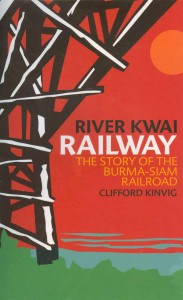 You’ve seen the terrific movie, you’ve read Philippe Boulle’s compelling book. Great stories, but they’re both fiction. For a worthy overview of the situation as it actually occurred, we at WoWasis recommend reading military historian Clifford Kinvig’s River Kwai Railway: the Story of the Burma-Siam Railroad (1992, ISBN 1-84486-021-3). An estimated 100,000 workers died during the construction of this enterprise, which ultimately failed to live up to its military potential: the gradient was too steep for wood-burning locomotives, it was harassed by Allied bombing and strafing, and derailments required constant attention.
You’ve seen the terrific movie, you’ve read Philippe Boulle’s compelling book. Great stories, but they’re both fiction. For a worthy overview of the situation as it actually occurred, we at WoWasis recommend reading military historian Clifford Kinvig’s River Kwai Railway: the Story of the Burma-Siam Railroad (1992, ISBN 1-84486-021-3). An estimated 100,000 workers died during the construction of this enterprise, which ultimately failed to live up to its military potential: the gradient was too steep for wood-burning locomotives, it was harassed by Allied bombing and strafing, and derailments required constant attention.
What makes Kinvig’s approach to the story most interesting is his adherence to the military reasons Japan acted the way it did, pushing sick POWs and paid coolies past their exhaustion points to death, in order to build a rail supply line that would compensate for the allies’ destruction of their merchant marine supply chain. There’s something of the old samurai philosophy of bushido as well, as Kinvig quotes Lt. Usuki, the Commandant of the deadly Konyu 2 camp which created Hellfire Pass: “The Japanese are prepared to work — you must work. The Japanese are prepared to eat less — you must eat less. The Japanese are prepared to die — you must be prepared to die.” And die they did, through overwork, cholera, and countless other reasons. Their graves fill two huge cemeteries in the Kanchanaburi province.
In contrast to what is stated in Boulle’s fine novel, the Japanese were not novice railroaders, having built bridges over tough terrain in other parts of the world. They were not stupid, and it seemed were always looking at new ways to win a war that was lost practically as soon as it started. As Kinvig points out, there must have been conflict at a higher level over whether the broken-down human resources of the West were ever going to be healthy enough to complete the task in just over a few months. The Asian coolies who worked on the railway, many of whom were Burmese or Tamil workers from the rubber plantation of Malaya, suffered as much as the POWs. Many brought along their families with them as they worked. Cholera, dysentery, and a number of other killers condemned their families to death as well.
The cholera situation was grim, as the bacillus is passed by flies, in this case attracted by the open latrines. What about the brothel train, running along the tracks for Japanese soldiers? Kinvig reports that “on several occasions the girls gave cash and cigarettes to the destitute POWs.” If the book has a failing, it’s that the author’s prose is occasionally tedious. He relies on necessary facts and figures perhaps too heavily at the expense of storytelling. Many times throughout the book he makes reference to items that would appear to be fascinating: how could the locomotives have better climbed the gradient? What’s the story behind the brothel train? How were the women recruited? Such questions should, one would think, be at least addressed in endnotes
On the plus side, Kinvig does a wonderful job describing the plight of the Tamil workers from Malaya, who tend to get ignored in discussions surrounding contributions to, and deaths resulting from work on this railway.
All in all, a serviceable, competent book that could have benefitted from less of an emphasis on pure statistics, and more on some of the side stories that were, in all probability, fascinating enough that they would have made a worthy addition by their inclusion.
Leave a Reply